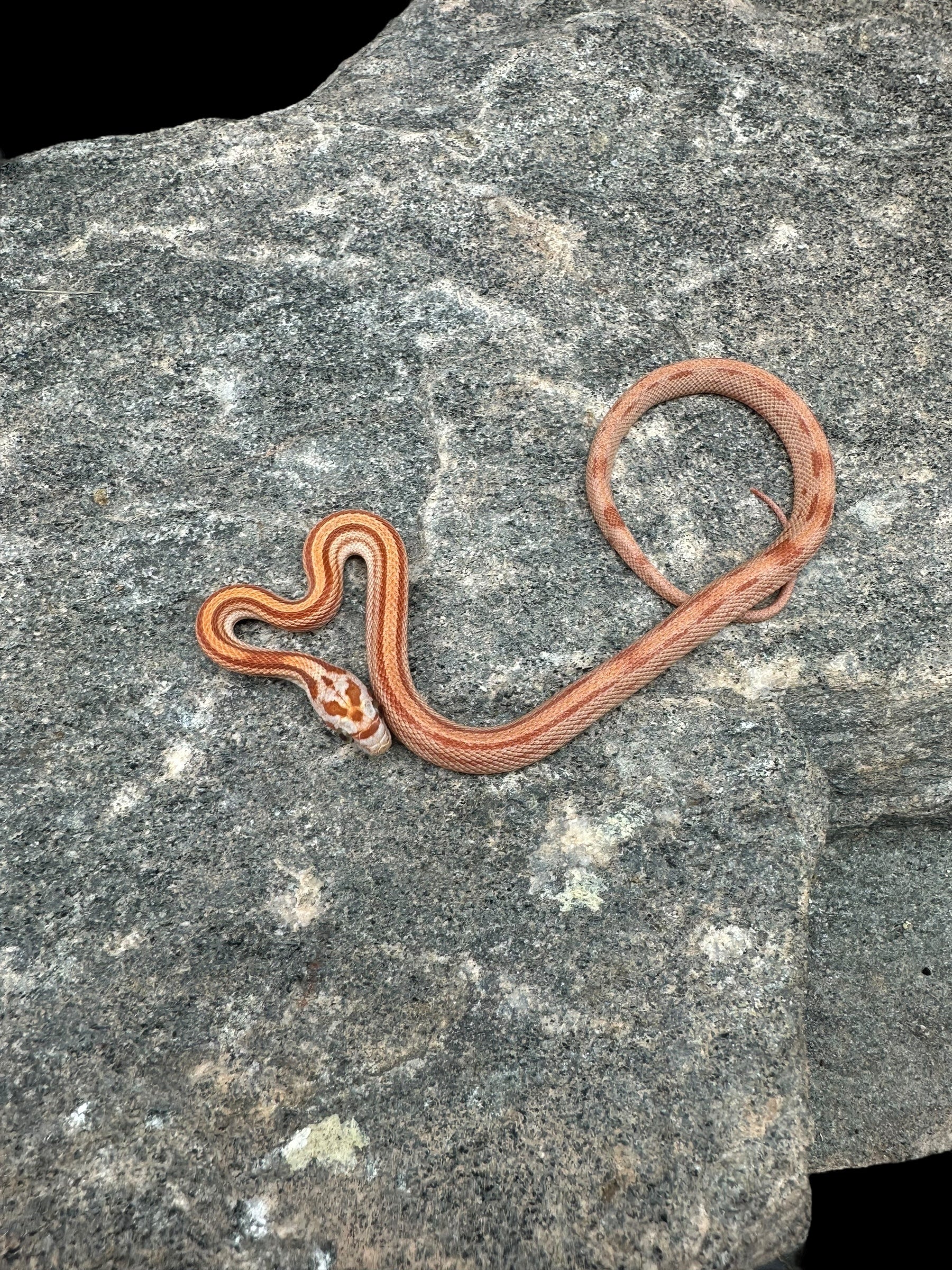Photo Disclaimer
Description
Corn Snake (Hypo Stripe)
Scientific Name: Pantherophis guttatus
Common Name: Corn Snake
Species Overview
Size: Adults typically reach 3–5 feet (0.9–1.5 m) in length, with a lean, agile body and smooth, glossy scales.
Appearance: The Hypo Stripe Corn Snake is a clean, soft-toned morph that showcases a striking striped pattern over a warm, desaturated color palette. This Corn Snake features two to four continuous dorsal stripes running the length of its body, replacing the classic saddle pattern. The Hypomelanistic gene reduces black pigmentation, resulting in warm shades of peach, orange, and tan bordered by light gray or cream. The overall appearance is smooth and uniform, with the stripes providing a refined linear contrast against the pale background. The belly pattern is lightly checkered, often faded or softened. The combination of brightness from Hypo and pattern alteration from Stripe creates a graceful, balanced look that highlights the natural elegance of the species.
Distribution: A selectively bred morph of the Corn Snake (P. guttatus), created by combining the Hypomelanistic and Stripe recessive traits.
Habitat: Wild Corn Snakes inhabit forest edges, meadows, and agricultural areas across the southeastern United States. In captivity, they thrive in naturalistic terrariums with climbing structures, secure hiding spots, and deep substrate for burrowing.
Behaviour: Calm, intelligent, and consistent. Corn Snakes are crepuscular, most active during dawn and dusk. The Hypo Stripe Corn Snake retains the species’ relaxed nature and strong feeding habits, making it an ideal morph for both hobbyists and breeders.
Captive Care
Enclosure: A naturalistic 40-gallon terrarium (36” × 18” × 18”) or larger is ideal for adults. A soil-based or bioactive substrate layered with leaf litter supports natural digging and exploration. Provide multiple hides, cork flats, climbing branches, and plant cover for enrichment and visual security.
Temperature & Humidity: Maintain a daytime gradient of 75–82°F (24–28°C) with a basking area around 86–88°F (30–31°C). Allow nighttime drops to 70°F (21°C). Keep humidity between 40–60%, with a humid hide provided during shedding.
Diet: Offer frozen-thawed rodents every 7–10 days for juveniles and every 10–14 days for adults. Prey size should be approximately 1.25× the width of the snake’s mid-body.
Behaviour in Captivity: Calm, gentle, and easy to handle. Corn Snakes thrive in structured, naturalistic environments. The Hypo Stripe Corn Snake’s blend of soft coloration and clean linear patterning makes it both a beautiful display specimen and a rewarding breeder morph.
Special Considerations: Color intensity can vary depending on lineage, with some individuals showing vivid orange striping while others display more muted pastel tones. Gentle, indirect lighting enhances their contrast without oversaturating their color.
Genetics Note
Hypomelanistic (Recessive)
Reduces black pigmentation, brightening and softening overall coloration while enhancing reds and oranges.
Stripe (Recessive)
Transforms the traditional saddle pattern into two or more continuous dorsal stripes running from head to tail.
Genetic Combination Summary
The Hypo Stripe Corn Snake expresses two visible recessive traits:
-
Hypomelanistic = Reduces black pigment, enhancing brightness and warmth
-
Stripe = Reorganizes dorsal saddles into continuous or broken longitudinal stripes
Together, these genes create a Corn Snake with a sleek, linear appearance and soft, glowing coloration. The Hypo Stripe Corn Snake is an elegant, balanced morph prized for its clean lines and calm disposition—ideal for keepers who appreciate understated beauty and strong genetic consistency.

